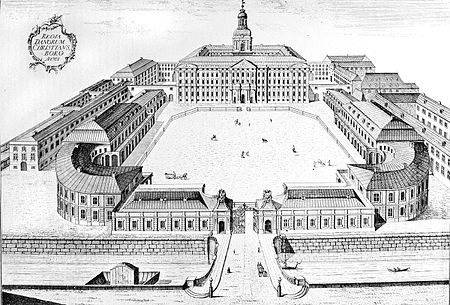Christiansborg Palace (1st)

The first Christiansborg Palace in Copenhagen, Denmark, was built on Slotsholmen in 1745 as a new main residence for King Christian VI of Denmark. It was built on the same site as its predecessor, Copenhagen Castle, which had assumed a monstrous appearance and started to crumble under its own weight after several extensions. The palace existed for just under half a century since it was almost completely destroyed by a fire in 1794. The surviving parts, which included the show grounds, the court theatre and the Marble Bridge with its two pavilions, were incorporated into the second Christiansborg Palace which succeeded it. These parts also survived the fire of 1884 which destroyed the second palace and are now part of the present day Christiansborg Palace which houses both the Danish Parliament, Supreme Court and Prime Minister's Office.
Excerpt from the Wikipedia article Christiansborg Palace (1st) (License: CC BY-SA 3.0, Authors, Images).Christiansborg Palace (1st)
Christiansborg Ridebane, Copenhagen Christianshavn
Geographical coordinates (GPS) Address Phone number Nearby Places Show on map
Geographical coordinates (GPS)
| Latitude | Longitude |
|---|---|
| N 55.6763 ° | E 12.5806 ° |
Address
Christiansborg Slot (Folketinget)
Christiansborg Ridebane
1218 Copenhagen, Christianshavn
Capital Region of Denmark, Denmark
Open on Google Maps









